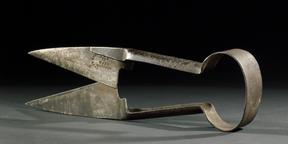

1:4 scale model of a bean drill
Model of a bean drill (scale 1:4) c. 1800
1:4 scale model of a bean drill, c.1800
Seed may be sown in one of four ways' it may be broadcast by hand or by seed fiddle, dibbled or drilled. The earliest method was to broadcast the seeds by hand although there is evidence that from 1700-1200 B.C. the Babylonians used a drill plough. Interest in drilling was practically non-existent in this century until it was stimulated primarily by the introduction of the turnip in the 17th century. In 1600 Sir Hugh Platt in his book "The setting of Corn" recommended a method for dibbling wheat, and in 1669 Worlidge suggested the drilling of wheat and outlined a machine for the purpose. The latter when constructed failed to work.
It was not until Jethro Tull produced his drill and horsehoe about 1700 and his book "Horsehorseing Husbandry" in 1733 that the first practical steps towards drilling were taken. Interest increased during the early 19th century and by 1860's, seed drills were of modern design in all essentials.
Basically a plough with a seed box added, this particular drill was used in Oxfordshire and Berkshire. The plough part was of Kent or Nolfolk design with a gallows bracket for adjusting the depth of working. he sowing mechanism, actuated by a trailing wheel, discharged the beans at regular intervals into the furrow prepared by the plough.
Details
- Category:
- Agricultural Engineering
- Object Number:
- 1931-99
- Materials:
- wood (unidentified) and metal (unknown)
- Measurements:
-
overall: 385 mm x 195 mm x 740 mm, 0.594 kg
- type:
- model
- credit:
- Mr. J.B. Passmore.




